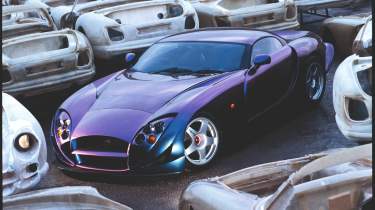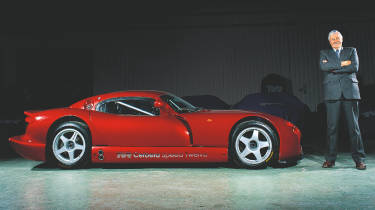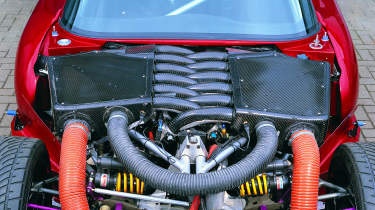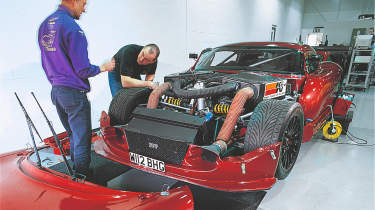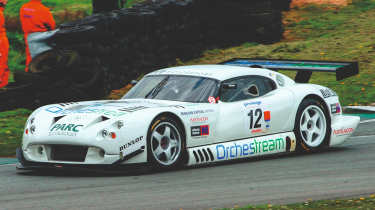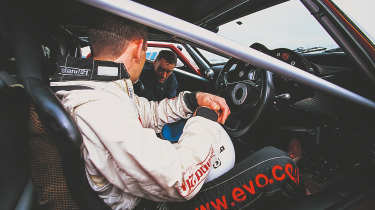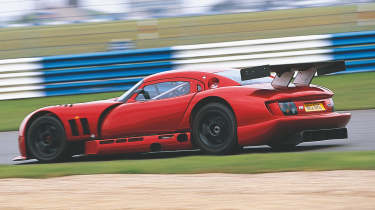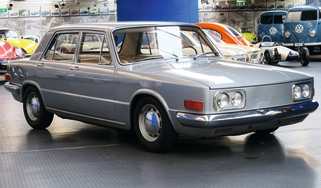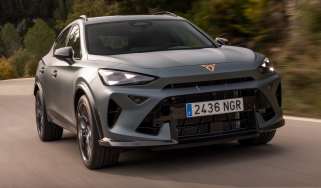TVR Cerbera Speed 12 – dead on arrival
The ultimate 'dead on arrival' supercar is the Cerbera Speed 12, a car even TVR was too afraid to put in public hands
There’s always been a North Star for the DOA series, a car in the evo universe that typified the kind of interesting, implausible, almost showroom-ready project on which DOA feasted, and here it is: the TVR Cerbera Speed 12. This is a car that seemed to deserve more than a single page and so, with DOA at the end of its run, we finish the series with a look back at the greatest and craziest pre-doomed production car in history.
> TVR Griffith (1990 - 2002) – Britain’s ‘anti-Porsche’ was a raw sports car
The Speed 12 began life in the mid-1990s and kicked off, as many things did at TVR, with an argument. In this case, it was a spirited debate about engines between boss man Peter Wheeler and engineer John Ravenscroft, which started with the cylinder heads of the forthcoming in-house Speed Six engine and ended, somehow, with TVR deciding to make a V12.
This wasn’t a piece of abstract madness, much though many TVR decisions seemed otherwise, because Wheeler had noticed the success of the McLaren F1 in GT racing and wanted his company to get a slice of that action. To stand a chance, however, a TVR GT1 car would need a McLaren F1-rivalling engine, and that’s where the V12 came in.
Unfortunately, TVR didn’t have a boundless engine budget, not with the home-grown AJP8 about to come on stream and an in-house straight-six to follow. There wasn’t even the money to cast a new aluminium block for a V12, but with a blend of Blackpudlian determination and an enormous amount of welding, a block was fabricated out of steel instead. The chassis, as per TVR tradition, would be a tubular-steel spaceframe with integrated roll-cage.
But TVR being TVR, things couldn’t stop at a GT1 car. There had to be something to wow the crowds at the British motor show, so a ‘road car’ version was created, or rather a full-size mock-up of such a thing, and put on display at the NEC in October 1996, painted vivid purple and labelled Project 7/12 because it had a 7.7-litre engine and 12 cylinders. It made 660bhp, TVR said, and would start testing in race form by early 1997.
Production would follow at some point, they added, and this vague claim was enough for deposits to be taken, including a pair of orders from existing TVR owners Keith Flint and Liam Howlett of The Prodigy. Unfortunately, by the time a running car made its test debut at Snetterton in 1998, now labelled Speed 12, big-budget GT1 entries from Porsche and Mercedes had made the series look a lot less appealing for a tiddler like TVR. Peter Wheeler cancelled TVR’s GT1 ambitions, scrapped Project 7/12 and declared the whole thing a great success.
As well he might, since TVR had saved cash by not going GT racing and made money licensing the car’s design to Scalextric and the people behind the TOCA and Gran Turismo video game series, thereby turning a profit on a car it didn’t race or sell. Wheeler called it ‘the perfect business model’.
The original show car was dumped at the back of the factory and allowed to gather rainwater in its dramatically concave bootlid until some wag from the design team dropped a bright yellow bath toy in the resulting puddle, after which the car was nicknamed ‘the duck pond’.
The running car in race trim was broken up for bits, leaving its V12 engine going spare. And clearly that seemed a waste. So, from the ashes of Project 7/12 came the Cerbera Speed 12, still using the steel-blocked V12 but now married to a chassis using folded aluminium and honeycomb as well as steel tubing and dressed in a shell with a stronger resemblance to the contemporary road car range.
Once again TVR made some big claims: there would be a racing version, this time for GT2, and there would be road cars which, unfettered by FIA restrictions, would generate a sensational 960bhp, a number TVR had arrived at after testing each bank of the engine separately and finding 480bhp a side. We couldn’t test the whole engine at once, went the claim, because we tried that once and the factory dyno ‘blew up’. And so began the legend of the Cerbera Speed 12.
You’ll see the dramatic dyno-death story repeatedly endlessly whenever this car is mentioned, and the genius of TVR PR at the time was to never let facts get in the way of a good story, but the truth is a little more prosaic: at worst the engine snapped the input shaft and if the TVR dyno broke at all it was probably because the TVR dyno broke quite often anyway.
Still, exploded test equipment or not, the Cerbera Speed 12 was on its way. More fabricated steel blocks were made – five in total, though not all got running – and work began on the racing cars. One car took part in the 2000 British GT Championship, winning the Silverstone round in the rain, and the following year TVR was back with a pair of Speed 12s, this time taking two wins during the season.
Tellingly, the second car only competed in the first four races before all efforts were consolidated into one machine, giving a clue as to TVR’s limited supply of Speed 12-specific parts. But that supply was about to get a small boost, thanks to developments on the road car side of the project.
The first Cerbera Speed 12 road-going prototype had been completed in 2000, a silver car registered W312 BFV. Soon afterwards another, more famous Speed 12 prototype appeared, a red car registered W112 BHG. The second example was useful because motorsport rule-makers had been asking questions about the Speed 12’s legitimacy as a production road car rather than a one-off prototype.
Two very finished-looking cars helped assuage the inspectors’ concerns, though when they asked to see the silver car again they were told that it had already been sold and shipped off to a ‘very secretive collector in Japan’. But, in that great tradition of motorsport (and the chocolate biscuit factory in Bagpuss), a naughty trick was being played. There was no secretive collector in Japan and the red car was just the silver car, resprayed and re-registered.
Soon afterwards Peter Wheeler took this sole example home for the evening and, as Speed 12 legend has it, was so alarmed by its behaviour that he cancelled the road car project the very next day. That’s the folklore, and it’s certainly rooted in truth. ‘I knew within 300 yards that it was a silly idea,’ Wheeler later said. ‘Over 900bhp in a road car weighing just over a ton is plainly ridiculous.’ But in truth it wasn’t just the batty power-to-weight ratio that caused the pragmatic Wheeler to nix the Cerbera Speed 12.
The car was a tiresome handful at low speed, not because of its power but because it was very wide and had such terrible steering lock it couldn’t make it around a mini roundabout in one hit. It was also proving hard to find off-the-shelf tyres for the car, and TVR wasn’t in a position to commission bespoke shoes for its bonkers flagship. So the road-going Speed 12 was officially cancelled, customer deposits were returned, and the lone prototype was slowly cannibalised to keep the racing effort rolling.
A single racing Cerbera Speed 12 took part in the 2002 British GT Championship and actually did quite well, placing on the podium in seven of the 12 rounds, justifying the cheeky slogan across its tail which said, ‘If you can read this the pace car must be out.’ But despite solid success, the racing programme always danced on a knife edge of thin budget and meagre parts supply. Only a lot of hasty pit-garage rebuilds kept things going, so it was no surprise that at the end of 2002 the car’s racing career ended for good.
It seemed safe to assume this was the last anyone would hear of the Cerbera Speed 12 but that was to underestimate the freewheeling silliness of TVR. It was never a company to play by the rules but it was a company to suddenly advertise a wildly powerful one-off prototype for sale through Auto Trader. And in August 2003 that’s exactly what it did.
What brought on this sudden urge to sell a previously unsaleable car isn’t clear, but it’s most likely that Wheeler, famously unsentimental about past projects, simply wanted what remained of this beast off his premises while realising he could make a few quid if he didn’t send everything to the scrapyard. So a buyer was found, personally ‘vetted’ by Wheeler himself, and then the red prototype W112 BHG was rebuilt with the carbonfibre shell from one of the racing cars and whatever working bits were left.
The end result was more racer than road car, as evinced by the low oil warning on the display of the Stack instrument pack that simply said ‘Pit, you bastard’, but during the rebuild the new owner opted for slightly less lumpy ‘road’ cams, knocking power down to a mere 880bhp. Nonetheless, this was still the wildly overpowered car of legend, the one that had scared off even the unflappable Peter Wheeler.
When John Barker got to drive it for evo 079 in 2005 he painted a vivid picture of the baying lunacy at its heart, writing that ‘the sound is HUGE and absolutely glorious, like an Italian V12 but one fuelled by broken glass and 100-octane anger’. Given an empty Silverstone to play on, Barker encountered second-gear wheelspin creeping down the pitlane and lurid oversteer as soon as he entered the first corner, prompting him to describe the throttle as being like the plunger on an old-fashioned detonator.
On the plus side, once the V12 was warmed up, Barker reported that it pulled ‘very cleanly, filling the cockpit and a good deal of Northamptonshire with a howl reminiscent of a Spitfire’. In the name of thorough testing, Barker ended his report by switching the Speed 12’s slicks for a set of Goodyear Eagle F1s and heading onto the public road, where he found a firm prod of the throttle in any of the first four gears would have the tyres fizzing and the whole car slithering. ‘Surrounded by trees and hedgerows,’ he concluded, ‘the Speed 12 feels about twice as quick as it did on the flat, wide track at Silverstone. Terrifyingly, crazily quick.’ John’s experience was so intense that the Cerbera Speed 12 remains the only car in the history of evo’s five-star rating system to receive a score of 11½.
The first owner enjoyed this intensity for a few years, working with former TVR race engineers to refine the experience, until in 2010 W112 BHG was sold again, this time to a man who also bought all the remaining Cerbera Speed 12 bits from the dormant TVR factory and used them to construct a second car, complete except for its engine. He used an Aston Martin V12 instead. A company called Helical Technology has since scratch-built two very similar-looking Speed 12 homages, also Aston V12 powered, to serve as test beds and demonstrators for its engine tech.
There’s clearly a lot of love for the Cerbera Speed 12 shape, perhaps thanks to its appearances in various Gran Turismo games. And its magnetism was shown once more in May 2023 when that only ‘official’ road car came up for sale again, this time through Silverstone Auctions, and sold for a remarkable £601,500. The Cerbera Speed 12 might not have made production, but the fact that the road car prototype exists to this day, has become extremely valuable and seems to be spawning lookalikes says a lot about its star quality. It was ambitious and daft and dramatic and attention seeking, and the evo world was made illogically and inexplicably better by its existence. In many ways, the Cerbera Speed 12 was the perfect encapsulation of Wheeler-era TVR.
Many thanks to former TVR PR supremo Ben Samuelson, who advised on this story in league with ex-TVR engineers John Ravenscroft and Neill Anderson. They’ve asked us to point out that any inaccuracies are because they can’t remember everything on account of ‘being old’.
